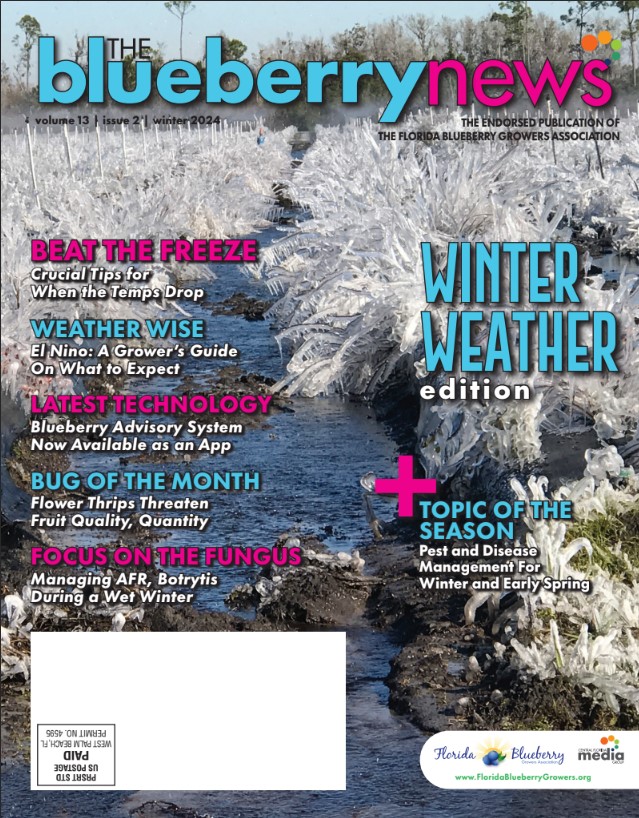Blueberry gall midge larvae feed on blueberry floral bud tissues, causing brown lesions, and bud death and abortion (Figure 1). When there is heavy gall midge injury, the bloom will typically be lighter since many of these buds will abort, resulting in decreased fruit set. It should be noted that poor fruit set and excessive dropping of undeveloped green fruit can also be caused by poor pollination.
Figure 1. Blueberry gall midge larvae feeding on floral buds
Credits: O. Liburd, UF/IFAS
The adult blueberry gall midge is slightly smaller than a mosquito (around 2-3 mm), and females are larger than males (Figure 2). The adult fly lives for only 2 to 3 days, and becomes active when the temperature exceeds 60° F. A single female is capable of laying as many as 15 eggs per bud, forcing its egg laying organ between the folds of flower buds just after bud swell, when scales begin to separate. The larvae pass through three stages and during this time feed on the interior of floral bud tissues. The larvae then drop to the ground to pupate in the soil and emerge as adults. It is believed that adult males typically emerge approximately two weeks before adult females.
Figure 2. Adult blueberry gall midge
Credits: O. Liburd, UF/IFAS
It appears that mild winters characterized by cool and warm spells facilitate high midge activity. In central Florida, the adult fly becomes active in late fall (November to December) and peak activity appears to be in January and February. In north-central Florida adults are active in November; however, cool temperatures in December and early January can negatively affect midge populations. Peak activity in north-central Florida occurs from late February to March.
Gall midge larvae are difficult to kill with contact insecticides since they develop and feed inside the floral buds. Insecticide applications must be timed to control adults before they lay eggs, which requires careful monitoring. Clear sticky traps hung in blueberry bushes close to the ground can be used to monitor adults (1–3 traps per acre). Alternatively, a white bucket trap with a sticky Plexiglas top placed under bushes in direct contact with soil or pine bark can detect new adults emerging from the ground (3–5 traps per acre). The adult blueberry gall midge must be viewed with magnification, and can be distinguished from other midge species by their antenna structure, which resembles irregularly shaped balls connected by short stick-like segments. Recommended chemical controls should be used when there are two or more adults present in the traps. If traps are not used for monitoring, preventive spray applications can be made. The first application should be made right before floral bud break, with a second application made ten days later. Monitoring for larvae can be done by placing young stems with buds into a ziplock type plastic bag at room temperature. Small translucent larvae that mature in 4-5 days will begin to emerge if present in the buds.
Field trials conducted by the University of Florida indicated that Exirel® (cyantraniliprole), Assail® (acetamiprid), Movento® (spirotetramat) with adjuvant, and Malathion® were effective in reducing adult populations. Larval populations were reduced with Assail®, Movento® with adjuvant and Exirel®. However, these products cannot be used when pollinators are present in the field. Delegate® (spinetoram) is typically used for gall midge management during or near bloom time. Please read the label and follow all directions for rates, frequency of application, and restrictions.
For additional information on blueberry gall midge see Blueberry Gall Midge on Southern Highbush Blueberry in Florida (https://edis.ifas.ufl.edu/publication/IN1239).
Dr. Oscar Liburd, Professor, UF/IFAS
Doug Phillips, Blueberry Extension Coordinator, UF/IFAS





